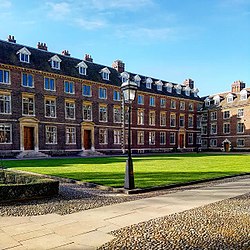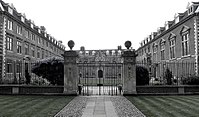St Catharine's College, Cambridge
| St Catharine's College Latin: Aula sancte Katerine virginis infra Universitatem Cantabrigie
| |||||||||||
 Main Court, St Catharine's College | |||||||||||
|---|---|---|---|---|---|---|---|---|---|---|---|
 | |||||||||||
| Master: | Sir John Benger | ||||||||||
| Website: | caths.cam.ac.uk | ||||||||||
| |||||||||||
| Location | |||||||||||
| Grid reference: | TL44775817 | ||||||||||
| Location: | 52°12’10"N, -0°7’1"E | ||||||||||
St Catharine's College is a constituent college of the University of Cambridge. Founded in 1473 as Katharine Hall, it adopted its current name in 1860. The college is nicknamed "Catz".
The college is located in the historic city-centre of Cambridge, and lies just south of King's College and across the street from Corpus Christi College. The college is notable for its open court (rather than closed quadrangle) that faces towards Trumpington Street.
History
Foundation

Robert Woodlark, Provost of King's College, had begun preparations for the founding of a new college as early as 1459 when he bought tenements on which the new college could be built. The preparation cost him a great deal of his private fortune (he was suspected of diverting King's College funds), and he was forced to scale down the foundation to only three fellows. He stipulated that they must study theology and philosophy only. The college was established as "Lady Katharine Hall" in 1473. The college received its royal charter of incorporation in 1475 from Edward IV. Woodlark may have chosen the name in homage to the mother of Henry VI, Catherine of Valois, although it is more likely that it was named as part of the Renaissance cult of Catherine of Alexandria, a patron saint of learning. The college was formally founded on St Catherine's day (25 November) 1473.[1] The Catharine wheel, a symbol of the saint's martyrdom, appears on the college arms.

The initial foundation was not well-provided for. Woodlark was principally interested in the welfare of fellows and the college had no undergraduates for many years. By 1550, however, there was a number of junior students and the focus of the college changed to that of teaching undergraduates.
The Robinson vote
In 1861, the master, Henry Philpott became Bishop of Worcester, and stood down. Two of the five Fellows of the college stood for election: Charles Kirkby Robinson and Francis Jameson. Jameson voted for his rival; however, Robinson voted for himself and won the election. The episode brought the college into some disrepute for some years.[2] Robinson's long tenure as master only ended with his death in 1909.
Expansion and modern day
As the college entered the 17th century, it was still one of the smallest colleges in Cambridge. However, a series of prudent masters and generous benefactors were to change the fortunes of the college and expand its size. Rapid growth in the fellowship and undergraduate population made it necessary to expand the college, and short-lived additions were made in 1622. By 1630 the college began to demolish its existing buildings which were decaying, and started work on a new court. In 1637 the college came into possession of the George Inn (later The Bull Hotel) on Trumpington Street. Behind this Inn was a stables which was already famous for the practice of its manager, Thomas Hobson, not to allow a hirer to take any horse other than the one longest in the stable, leading to the expression "Hobson's choice", meaning "take it or leave it".
The period of 1675 to 1757 saw the redevelopment of the college's site into a large three-sided court, one of only six at Oxbridge colleges; the others are at Sidney Sussex, Jesus and Downing at Cambridge, and Trinity College and Worcester, St Catharine's sister college, at Oxford. Proposals for a range of buildings to complete the fourth side of the court have been made on many occasions.

The college was granted new statutes in 1860 and adopted its current name. In 1880, a movement to merge the college with King's College began: the two colleges were adjacent and it seemed a solution to King's need for more rooms and St Catharine's need for a more substantial financial basis. However, the Master (Charles Kirkby Robinson) was opposed and St Catharine's eventually refused.
In 1966 a major rebuilding project took place under the mastership of Professor E. E. Rich. This saw the creation of a new larger hall, new kitchens and an accommodation block shared between St Catharine's and King's College. Pressure on accommodation continued to grow, and in 1981 further accommodation was built at St Chad's on Grange Road, with further rooms added there in 1998. In 2013 the College completed the building of a new lecture theatre, college bar and JCR.
In 1979, the membership of the college was broadened to welcome female students.
Outside links
| ("Wikimedia Commons" has material about St Catharine's College, Cambridge) |
References
- Jones, W. H. S. (1936). A History of St Catharine's College: once Catharine Hall, Cambridge. Cambridge: Cambridge University Press.
- Jones, W. H. S. (1951). The Story of St Catharine's College, Cambridge. Cambridge: W. Heffer.
- Rich, E. E., ed (1973). St Catharine's College Cambridge 1473–1973: a volume of essays to commemorate the quincentenary of the foundation of the College. Cambridge: St Catharine's College. ISBN 0950310808.
| Colleges of the University of Cambridge | |
|---|---|
|
Christ’s • Churchill • Clare • Clare Hall • Corpus Christi • Darwin • Downing • Emmanuel • Fitzwilliam • Girton • Gonville and Caius • Homerton • Hughes Hall • Jesus • King’s • Lucy Cavendish • Magdalene • Murray Edwards • Newnham • Pembroke • Peterhouse • Queens’ • Robinson • St Catharine’s • St Edmund’s • St John’s • Selwyn • Sidney Sussex • Trinity • Trinity Hall • Wolfson |
 |
